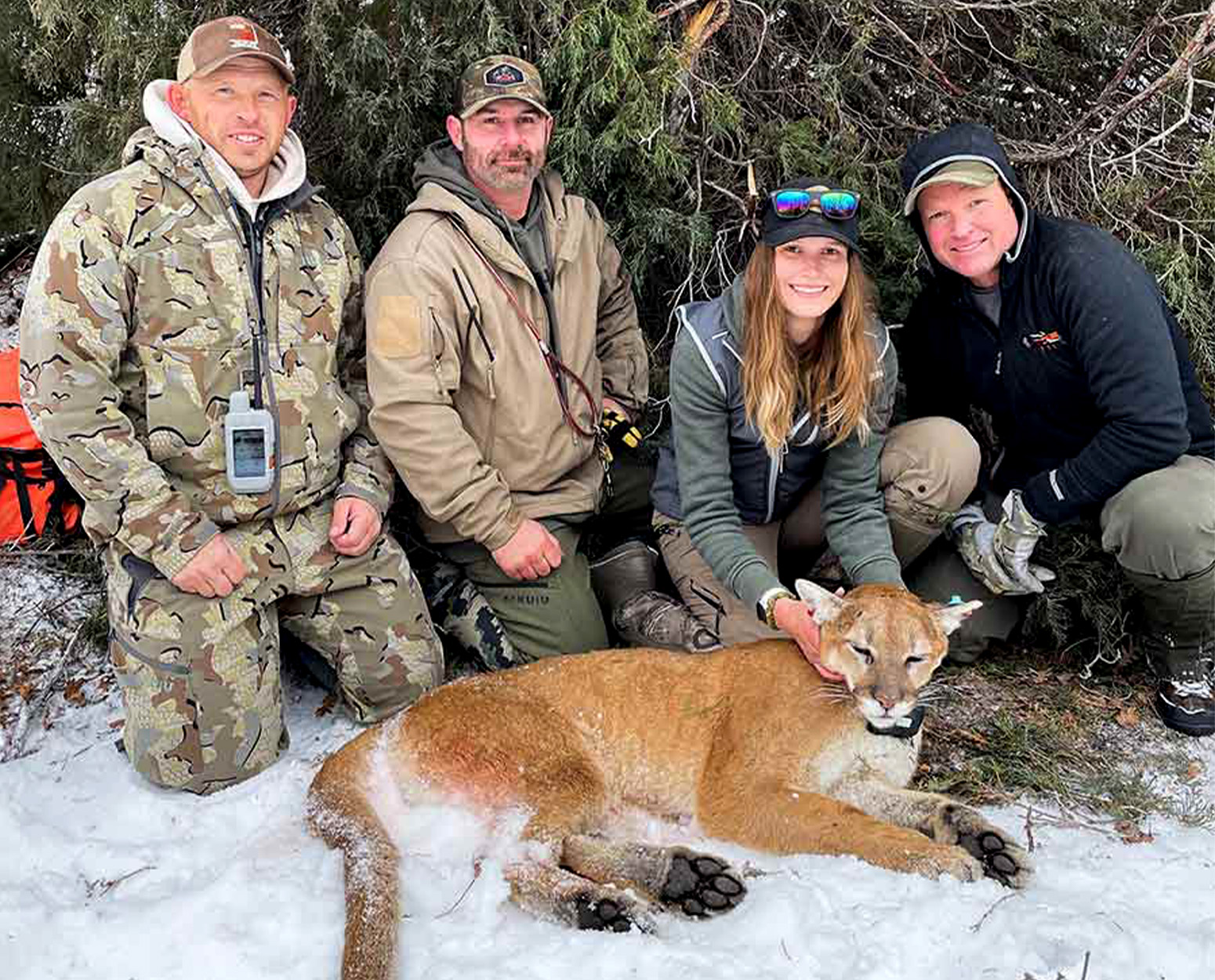GPS tracking data shows how the cougar made its way through the Rocky Mountains, crossing reservoirs and freeways

Utah DWR biologist Morgan Hinton (center right), another biologist, and two houndsmen with “F66,” the mountain lion they collared in February 2022. Photograph courtesy Utah DWR
A recent YouTube video shared by the Utah Division of Wildlife Resources shows one GPS-collared mountain lion’s epic journey across the West. The big cat’s roughly 1,000-mile trek began in May 2022, when the adult female lion known as F66 set out from the Wasatch Mountains in central Utah. Its journey came to an end on the eastern slope of Colorado’s Front Range in November, when it was killed by another cougar.
Covering around 6 miles a day for 165 days straight, the mountain lion passed through three states, swam a major reservoir, and survived multiple freeway crossings, showing the incredible lengths these animals are willing to go in their efforts to establish new territories.
“F66’s journey is one of the furthest ever recorded for GPS-tracked cougars,” DWR biologist Morgan Hinton writes in a press release.
Hinton explains that the agency started using GPS collars to track cougars in 2018. They’ve since collared more than 60 adult cougars in Utah, many of which have crossed into neighboring states. She says all this data has helped biologists identify the key travel corridors that cougars use while giving them a better understanding of why cougars undergo these journeys in the first place — and how their movements are influenced by age and sex.
F66, a 2-year-old female, was caught and fitted with a GPS collar in Utah’s Wasatch Range in February 2022. She stuck around the area until May 30, when she set out on her long, circuitous walk into southwest Wyoming and then down into Colorado. Hinton clarifies that this was not a migration but a “dispersal,” which is a one-way trip away from a home range.
Because cougars are solitary predators that occupy and defend their large territories from other cougars, they regularly seek out new home ranges. Research has shown that subadult males born in areas with dense cougar populations have no choice but to leave home. And while F66’s trip is impressive, it’s not the first — nor the furthest — cross-country journey that’s been documented by wildlife biologists.
Part of a Larger Eastward Trend
As cougar populations remain healthy across their core range in the western U.S., they seem to be dispersing even further with greater frequency. This has been documented in several states where cougars have been absent for a century or more. Wildlife biologists in Minnesota and Wisconsin are seeing more transient cougars coming into these states from the Dakotas. In November, a Wisconsin bowhunter killed one in self-defense. It was the first mountain lion killed in the state in 115 years, and a biologist with the state’s Department of Natural Resources said he believes the cat came from the Dakotas as well.
“As the different pockets of available territory become no longer vacant, they have to go elsewhere. That’s what we think is happening,” University of Minnesota researcher Michelle LaRue explained to Scientific American in 2012. “There are no more pockets of vacant habitat in the West … and elsewhere happens to be the Midwest where there’s habitat but no competing cougars.”
Read Next: Watch: A Biologist Darts a Mountain Lion. It Nearly Attacks Him
This is also happening in places further south. Just last week, the Arkansas Game and Fish Commission announced the discovery a dead mountain lion in the northern part of the state. It was the first lion carcass seen there in a decade, and it added to the nearly two dozen confirmed lion sightings that have been recorded in Arkansas since 2010, according to AGFC spokesman Keith Stephens. Biologists there also believe these cougars are working their way southward and eastward from Wyoming and South Dakota.
Still, the most impressive cougar dispersal event — at least that was widely covered — occurred in 2011, when researchers inspected a mountain lion that was hit by an SUV in Connecticut. (Up to that point, no confirmed sightings of mountain lions had occurred since the 1800s). Using DNA testing, they determined that the lion had traveled there from South Dakota’s Black Hills by way of Wisconsin and Minnesota, covering more than 1,500 miles on its way.
